Long sitting can affect the mobility of your upper back and weaken the back muscles. That’s why it’s important to exercise your back muscles.
Bodyweight exercises are the perfect addition to your home routine to strengthen your back. That’s because strengthening your back muscles— lats, rhomboids, and traps—helps improve muscle imbalances and posture.
They OFFER many other benefits, Like:
- Allows for greater flexibility, joint safety, and stabilization.
- These are beginner-friendly workouts. However, with the variations and modifications, you can make them challenging even if you are an advanced lifter.
- Allow the joints to move naturally within their range of motion by creating more joint stability.
- Perfect for the at-home exerciser with limited space.
Today, we’ll review some of the best bodyweight back exercises for your upper, middle, and lower back.
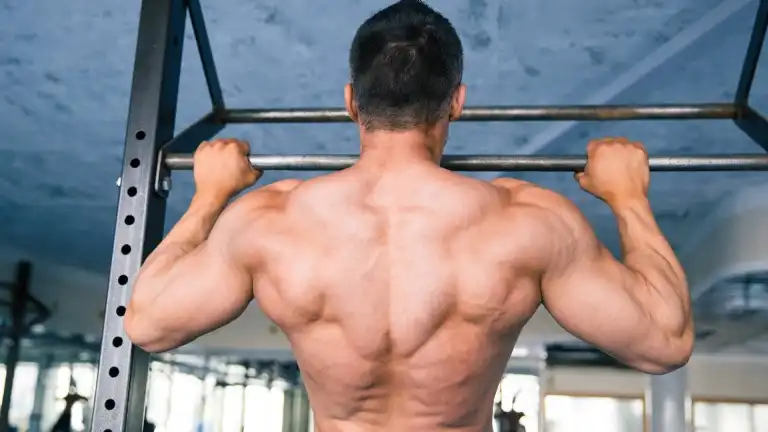
- Back Muscles (Anatomy)
- 15 Best Bodyweight Exercises For Beginners to Advance
- 1. I, Y, T, W
- 2. Cat Cow Pose
- 3. Prone Cobra
- 4. Side Plank Rotations
- 5. Inverted Row
- 6. Pull-Up
- 7. Superman
- 8. Lying Bent-Knee Oblique Twist
- 9. Good Morning
- 10. Hip Bridge
- 11. Flat Bench Hyperextension
- 12. Chin Up
- 13. Bird Dog
- 14. Scapular Push-Ups
- 15. Hindu Push Up
- Bodyweight Back Workout Routine
- Beginner-Friendly
- Back Workout Without Equipment
- Advance Bodyweight Back Workout Plan #3:
- FAQ’s
- How often should we work on our backs?
- Can Bodyweight Exercises Build Muscle?
- Lower back bodyweight exercises.
- Upper Back Bodyweight Exercises
- Takeaway
- References
- Bodyweight Back Workout That Must Do At Home
Back Muscles (Anatomy)
To build a strong and muscular back at home, you must first understand the anatomy and functionality of the back muscles.
Your back muscles start just under your skull and down to your lower back, just above your hips. These muscles connect to your ribs, vertebrae, shoulder blades, and neck.
Your back comprises three groups of muscles: Superficial Muscles, Intermediate Muscles, and Intrinsic Muscles.
Superficial Muscles are closer to the skin’s surface and comprise the upper and lower back muscles. Includes:
- Latissimus dorsi (lats): Commonly referred to as the “lats,” large muscles that extend from the middle and lower back to the armpits
- Rhomboids: Located between the shoulder blades. They run from the medial border of the scapula (shoulder blade) to the spine.
- Trapezius (traps): Large, triangular muscle extending from the skull’s base to the mid-back.
- Levator scapulae: Located on the side and back of the neck. It runs from the upper cervical vertebrae to the upper border of the scapula (shoulder blade)
15 Best Bodyweight Exercises For Beginners to Advance
Below are several back exercises you can add to your bodyweight workout plan to build a bigger and stronger back.
1. I, Y, T, W
These exercises focus on the shoulder and back muscles, mainly the middle and lower part of the trapezius.
They also hit all the rotator cuff muscles, including the infraspinatus, subscapularis, teres minor, and supraspinatus muscles.
These work together to stabilize the shoulder and move the arm. Adding these back exercises to your workout regimen is necessary.
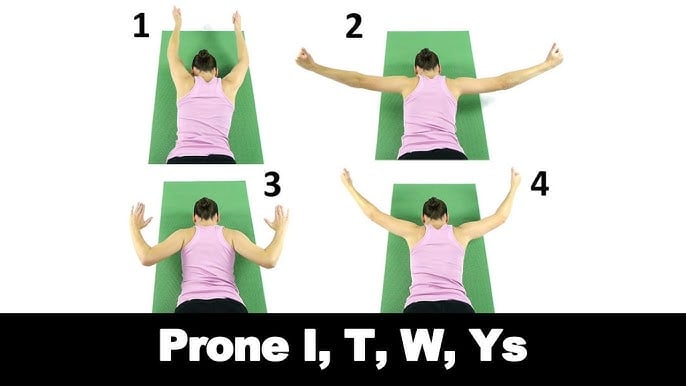
How To Do
- Gently exhale and slowly lift your arms off the floor (maintain a formation of the letter “I, W, T”).
- Keep your head aligned with your thoracic (upper) spine.
- Focus on using your shoulders to generate most of the lift, although some low back extension (arching) is acceptable.
Pro-Tips
- Beginners try to hold for only five or 10 seconds and work up to 30 seconds in future workouts.
- Maintain your head alignment with your thoracic (upper) spine.
- Move your arms slowly up and down in each position of I, T, W, and Y.
- Add a 1-3 pound weight in each hand to make the exercises more challenging.
- Do not hold your breath. Breathe regularly.
2. Cat Cow Pose
The cat-cow is a spinal mobilization exercise that helps people “loosen” their spine and improves lower back movement.
It’s great for working on stability, mobility, and control from the neck all the way down to the sacrum and tailbone.
If you struggle with back mobility, this is a great way to start. It will increase your chances of improving your back’s function and movement.
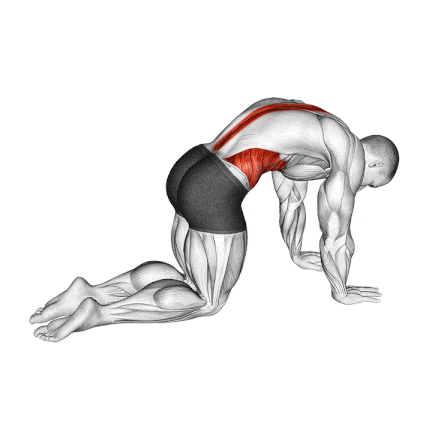
How To Do
- Begin with your knees beneath your hips and your spine in a neutral position.
- Sink your back down towards the floor and lift your head up simultaneously, sticking your tailbone out to curve your spine.
- Return to the initial position, and then tuck your head and tailbone in, arching through your spine as to mimic a camel hump. Take a big breath in at the same time.
- Move back and forth slowly, without pushing at either end of the movement.
- Do 8–10 repetitions to mobilize your lumbar spine or lower back area fully.
3. Prone Cobra
It’s called the Prone Cobra, a simple postural improvement exercise that will strengthen all the anti-slouch muscles of your back to improve your posture.
Believe it or not, the Prone Cobra can even help with stress. Opening up your chest and improving posture can create a sense of openness and release tension.
It is a simple and beginner-friendly back exercise you can do anytime, anywhere, and without any equipment.
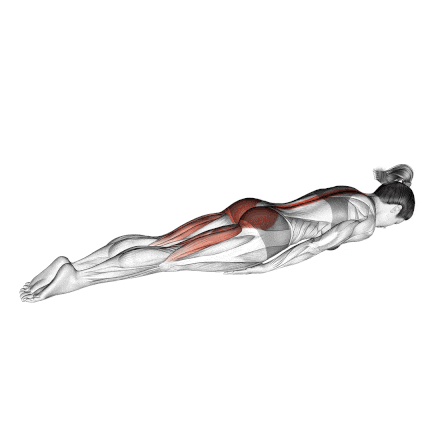
How To Do
- Lie down on the floor with your legs straight and your arms at your sides.
- Lift your chest off the floor and externally rotate your hands so your thumbs are pointing up.
- For advanced variation, you can lift both chest and leg.
- Squeeze your shoulder blades together and draw them down towards your hips.
- Keep your eyes pointing at the floor and maintain the tension for 10–30 seconds.
- Keep your feet on the floor and try to relax your buttocks.
4. Side Plank Rotations
While regular planks are great for your core muscles, mainly oblique. The rotational movement with side plank helps to develop core and shoulder strength & stability, and even help to improve back mobility.
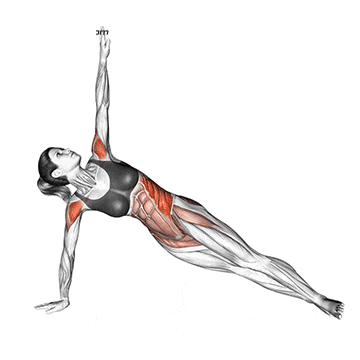
How To Do
- Get in a side plank position.
- Raise your body by placing your left arm (palm) flat on the floor so that it’s perpendicular to your torso. Avoid letting your hips sag during the exercise.
- Lift your torso until your left upper arm is straight underneath you, with your elbow bent 90 degrees and your arm flat on the floor.
- In this position, only your left arm and the outer side of your left foot are in contact with the floor.
- Reach under and behind your torso with your right hand, keeping your abs braced. And then repeat on the right side.
5. Inverted Row
The inverted row (bodyweight rows) creates a horizontal body position, making it easier to perform. It works the back and shoulder muscles from a different angle and improves upper body strength.
In the gym, most people utilize the Smith machine for this exercise.
You can also do the inverted row at home by lying under a chair and pulling yourself up.

How To Do
- Adjust the height of the chair and bar so that it’s a little higher than arm’s length from the floor.
- Lie under the bar with your legs and body straight. Grasp the bar with an overhand grip that’s a little wider than shoulder width.
- Keep your legs and body straight, and exhale as you pull your chest up towards the bar.
- Hold for a count of two and squeeze your back muscles.
- Breathe in as you lower your body until your arms and shoulders are fully extended. Repeat.

6. Pull-Up
The pull-up is an upper-body strength movement that targets your back, chest, shoulders, and arms. They are often a challenge for beginners and even experienced athletes to perform.
It is a great exercise for building upper body strength, improving posture, and increasing muscle mass.
The pull-up increases your back’s strength, thickness, and width, specifically your lats. The lats influence the back width and form the “V” in the upper back.
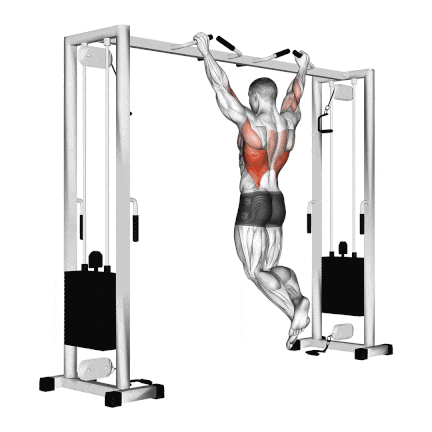
How To Do
- Using an overhand grip, grab a pull-up bar with your hands positioned at shoulder-width apart.
- Hang from the bar with your arms fully extended and your chest high, while exaggerating the arch in your lower back.
- Pull yourself up by squeezing your shoulder blades together and contracting your lats until your chin passes the bar.
- Hold the contraction at the top for a second before slowly lowering yourself back to the starting position.
- Go with the full range of motion and keep the form correct.
7. Superman
Superman is one of the best back exercises you can do without equipment. It strengthens your upper and lower back muscles.
If done regularly, it may help alleviate back pain that is related to weak back muscles.
It’s not just about your back! The Superman also works your glutes (butt muscles) and hamstrings (back of your thighs), giving you a bonus lower body workout.
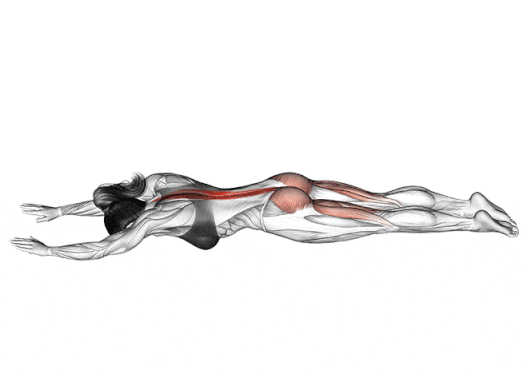
How To Do
- Lie down with your stomach flat on the ground. Extend your arms in front of you, with your palms down.
- Lift your head, raise your arms and chest off the ground as far as possible.
- Bend your legs and lift your thighs off the ground as much as possible. (Try to make a big “U” with your back.)
- At this point, you should feel your back muscles, glutes, and hamstrings tighten.
- Try to 5 or 10 seconds, and then work your way up to 30 seconds over time.
- Do not hold your breath. You should breathe regularly.
8. Lying Bent-Knee Oblique Twist
When you correctly do a lying bent knee twist, it can effectively strengthen the obliques and lower back. The twisting motion in this exercise helps improve your spine’s mobility.
Plus, it’s a move you can do anywhere. No fancy gym equipment is needed, just you and some floor space.
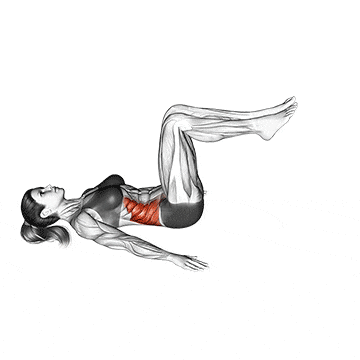
How To Do
- Lie on the floor with your arms extended to the sides to keep your body stable during the exercise.
- Bend your legs and raise your bent legs at a 90-degree angle so that your thighs are vertical and your lower legs are horizontal.
- Keep your shoulders in contact with the floor, and slowly lower your legs to one side until you feel a mild stretch in your lower back.
- Now, rotate your legs all the way to the right.
9. Good Morning
First of all, they’re like a secret tool for your lower back and hamstrings. But wait, there’s more! This exercise also works your glutes, core, and even your upper back. It’s like a full backside makeover in one move.
The erector spinae muscles of the lower back work isometrically to keep the spine in an extended position, while the hamstrings and gluteus maximus work isotonically to perform hip extension.
You should add this bodyweight exercise to your back workout routine to strength the lower back.

How To Do
- Stand with a stick on your back and grab it from either side.
- You can also perform the exercise as in the bodyweight version (No Stick).
- Keep your knees slightly flexed and your back and neck neutral.
- Inhale as you flex your hips to lower your torso until it is close to or fully horizontal.
- It is recommended that the lifter avoid rounding (flexing) or rotation (twisting) at any point during the movement.
- Exhale as you raise your torso back up to the starting position by extending your hips.
- Movement should be slow and deliberate, the form should be strict, and the weight should be light.
10. Hip Bridge
When you do glute bridges often, you are strengthening your glutes and lower back muscles. These muscles are meant to hold your body upright, so they will get stronger when you do this.
It’s a good rehab exercise for improving core and spinal stabilization and can be added to a warm-up routine or strength-training workout.
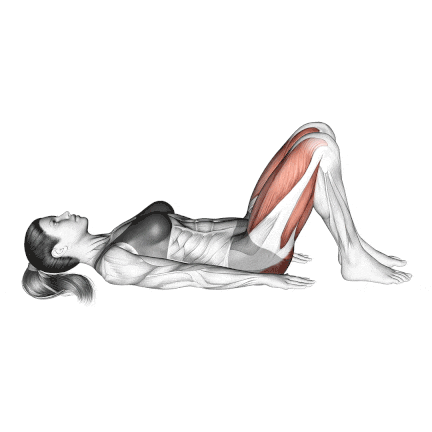
How To Do
- Lie down on the floor, with your knees bent and your feet flat on the ground.
- Keep your palms down while keeping your arms at your sides.
- Lift your hips off the ground until your knees, hips, and shoulders form a straight line.
- Please do not use your arms to push.
- Squeeze your glutes hard and keep your abs drawn in, so you don’t overextend your back during the exercise.
- Hold your bridged position for a few seconds and then go back down.
- You can increase its difficulty by holding a weight plate on your lap.
11. Flat Bench Hyperextension
This exercise targets your entire posterior chain, which includes your hamstrings, glutes, and all the muscles in your back. A strong posterior chain is essential for everything from everyday activities, such as bending and lifting, to athletic performance.
If you are new to lifting weights, start with your own weight. To make it harder, hold a plate to your chest or behind your head.
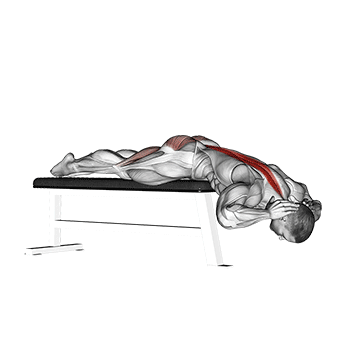
How To Do
- Lie face down on a flat bench with your torso off the end.
- Hook your heels under the bench to keep from falling forward.
- Or ask someone to hold your feet to help you stay stable.
- Place your hands on your chest (or behind your neck) and bend down through your waist.
- Return to the start position, but avoid extending beyond the body level.
- Remember to always keep your movements under control, without letting gravity take you down faster.
12. Chin Up
Pull-ups and chin-ups are two commonly used bodyweight exercises to strengthen upper-body muscles. They induce serious muscle growth in the back and biceps.
They are both performed using a pull-up bar; the main difference between the two exercises is the grip used.
- In chin-up, the palms face towards the body while the bar is gripped (underhand or supinated grip). This grip targets the biceps more than the back and shoulders.
- In pull-up, palms are faced away from the body (overhand or pronated grip) while gripping the bar. This grip targets the back and shoulders more than the biceps.
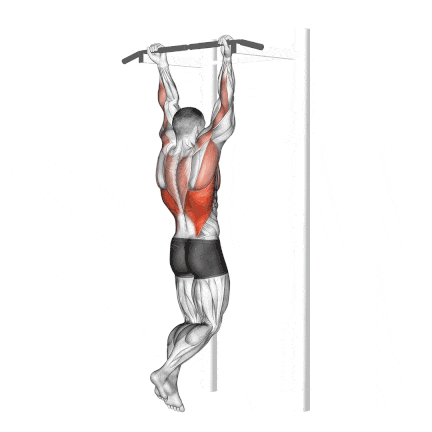
How To Do
- Grab a pull-up bar with an underhand grip (palm facing toward the body), and hands shoulder-width apart or slightly narrower.
- Pull your body until your chin becomes aligned with the bar. Make sure you retract your shoulder blades.
- Hold the muscles under maximum tension at the top for one to two seconds.
- Slowly return to the starting position.
- Lower to almost full extension of the elbow, but avoid locking out completely. Don’t start a habit of doing half-reps and chasing numbers.
13. Bird Dog
The bird dog exercise looks elegant and is very effective for training the core muscles and back muscles. Other muscles, such as the glutes, are also worked on.
It owes its name to the position alternating between sitting on hands and knees (dog) and stretching the arms and legs (bird).
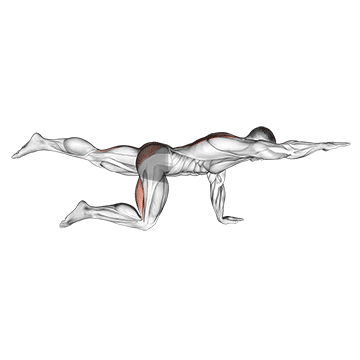
How To Do
- Get on your knees and place your hands on the floor in front of your body at shoulder width.
- Contract your abs and lift one hand and the opposite knee slightly off the floor. You are now balancing on the other hand and knee.
- Now extend your arm and leg all the way out.
- Don’t raise your leg and arm higher than your back. The exercise works best when you form a straight plane from your hand to your ankles.
- Hold this position for about 10 seconds and then return to the starting position. Repeat the exercise with the other side.
14. Scapular Push-Ups
Scapular push-ups are a variation exercise of the regular push-up. It is one of the best Rhomboid exercises.
It places greater activity on your rhomboids and serratus anterior muscles than the traditional push-up. This also results in higher recruitment of your scapular stabilizing muscles (the technical term for the shoulder blades).
The scap push-up promotes natural scapula motion and better shoulder mobility.
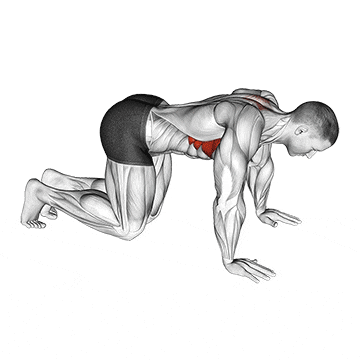
How To Do
- Get into a high plank position with your feet hip-width apart and your hands underneath your shoulders shoulder-width apart.
- Let your chest drop between your arms, so your shoulder blades merge together, “retract”.
- Use a small range of motion; do not lower your chest all of the way to the floor.
- From here, push through the palms of your hands slowly and round through your back to a protracted position. You will feel your shoulder blades spread apart.
- Then repeat: slowly go down and up. Be sure to breathe in on the way down and out on the way up.
15. Hindu Push Up
This variety of push ups has existed for centuries among Indian martial artists. It works on core strength, back, shoulders, hips, and triceps. It is a traditional Indian-style exercise practiced by wrestlers.
For each repetition, you move from a downward dog position to a cobra pose and swoop while keeping your head and body close to the ground.

How To Do
- Start in a downward dog pose, with your hands shoulder-width apart, your body in a V shape, and your feet hip-width apart.
- Bend your elbows and lower your chest until it’s just above the floor, going into low plank pose.
- In a scooping motion, lift your head upward while arching your lower and upper back, then go into cobra pose.
- Return to the starting position; you don’t need to reverse through the sweeping and arching motion.
Bodyweight Back Workout Routine
Beginner-Friendly
| Exercises | Sets | Reps |
|---|---|---|
| I, Y, T, W | 4 | 20-30 Sec |
| Prone Cobra | 4 | 8-12 |
| Pull-Up | 3 | 8-10 |
Back Workout Without Equipment
| Exercises | Sets | Reps |
|---|---|---|
| Cat- Camel | 4 | 8-12 |
| Side Plank and Rotate | 4 | 6-8 |
| Superman | 3 | 8-12 |
| Good Morning | 4 | 10-15 |
Advance Bodyweight Back Workout Plan #3:
| Exercises | Sets | Reps |
|---|---|---|
| Pull Ups | 4 | 8-12 |
| Superman | 4 | 8-10 |
| Scapular Push-Ups | 3 | 8-12 |
| Hindu push up | 4 | 10-12 |
FAQ’s
How often should we work on our backs?
Back workouts can be done at least two days a week, with a minimum of 48-72 hours of rest in between.
Can Bodyweight Exercises Build Muscle?
Yes, bodyweight exercises can build muscle using the following principles: increase reps, decrease rest times, perform variations, train to failure, increase time under tension, and implement mechanical drop sets.
Lower back bodyweight exercises.
- Superman
- Bridge Variations (Basic Bridge, Single-Leg Bridge, Glute Bridge March)
- Bird Dogs
- Bird Dog
- Back Extensions
- Cobra Stretch
- Dead Bug
- Hip Thrusts
- Good Mornings
- Hollow Body Hold
Upper Back Bodyweight Exercises
- I, Y, T, W
- Side Plank and Rotate
- Pull-Ups
- Chin-Ups
- Inverted Rows
- Scapular Push-Ups
- Bodyweight Rows
- Hindu Push Up
- Plank Rows
- T-Raises
Takeaway
This bodyweight back workout is highly recommended for anyone interested in building a wider back and gaining strength.
It helps build muscle in a specific area, strengthens the upper body, and increases muscle mass overall.
It is easy to do and requires no more scientific details or fancy equipment. You could try incorporating some of these 15 exercises into your bodyweight workout regimen.
The results will speak for themselves if you consistently do this bodyweight back workout.
Stay Fit, Live a Happy and Healthy Life
References
- Thomas, Ewan & Bianco, Antonino & Mancuso, Esamuela & Patti, Antonino & Tabacchi, Garden & Paoli, Antonio & Messina, Giuseppe & Palma, Antonio. (2017). The effects of a calisthenics training intervention on posture, strength and body composition. Isokinetics and Exercise Science. 25. 1-8. 10.3233/IES-170001.
- Schoenfeld, B. J., Ogborn, D., & Krieger, J. W. (2016). Effects of Resistance Training Frequency on Measures of Muscle Hypertrophy: A Systematic Review and Meta-Analysis. Sports medicine (Auckland, N.Z.), 46(11), 1689–1697.
- Hackett D.A., Johnson N.A., Chow C.M. Training Practices and Ergogenic Aids Used by Male Bodybuilders. J. Strength Cond. Res. 2013;27:1609–1617. doi: 10.1519/JSC.0b013e318271272a.
- Rahman Shiri, David Coggon: Exercise for the Prevention of Low Back Pain: Systematic Review and Meta-Analysis of Controlled Trials: American Journal of Epidemiology, Volume 187, Issue 5, May 2018, Pages 1093–1101
Bodyweight Back Workout That Must Do At Home

Manish is a NASM-certified fitness and nutrition coach with over 10 years of experience in weight lifting and fat loss fitness coaching. He specializes in gym-based training and has a lot of knowledge about exercise, lifting technique, biomechanics, and more.
Through “Fit Life Regime,” he generously shares the insights he’s gained over a decade in the field. His goal is to equip others with the knowledge to start their own fitness journey.

